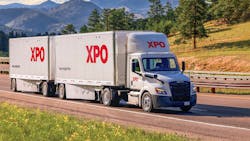XPO Inc. executives are pulling forward hundreds of millions of dollars in capital spending to take advantage of “the recent market dynamics and the opportunity at hand” because of the shuttering of Yellow Corp. this summer.
Speaking Oct. 30 after reporting XPO’s third-quarter results, CEO Mario Harik confirmed what he hinted at three months ago, days after Yellow had closed its doors: Connecticut-based XPO (No. 12 on the FleetOwner 500) will significantly increase its spending on tractors, trailers, and service centers to make sure it can bring on more business without hurting its operations. The company’s 2023 capex forecast has grown from a range of $500 million to $600 million to somewhere between $675 million and $725 million since August.
See also: Yellow bails on equipment auction, hires liquidators
That much higher range will put XPO’s capital spending this year at 12% to 13% of its revenue, above the range Harik and his team typically target. The CEO told analysts on a conference call that spending on equipment and real estate—XPO has so far this year bought 1,000 tractors and is on pace to build 7,000 trailers at its Arkansas plant—“will likely continue to exceed our target range in the near term.”
“We have the agility to capitalize on changes in market conditions,” Harik said on the conference call.
Picking up a lot of former Yellow customers is helping justify those investments: Chief Strategy Officer Ali Faghri said XPO’s shipments rose nearly 9% in July from a year earlier and were up 8.3% in August and 6.6% in September. The daily shipment count, he said, rose sequentially by more than 1,000 every month of the quarter. October’s seasonality has ended that last trend, but Faghri said shipments were still up 6% year over year.
XPO posted a third-quarter profit of $86 million, down from $92 million in last year’s Q3, in part because of the higher capex but also because pension income was down $11 million, and XPO booked $8 million in costs from the spin-off of the RXO brokerage business. Revenues came in at nearly $2 billion, up slightly year over year. Operating income climbed 11% to $154 million as XPO’s less-than-truckload operating ratio was essentially flat at 86.8%.
Adding to the confidence Harik and his team have in ramping up capex are other positive trends in XPO’s business. The company grew Q3 revenue per hundredweight (excluding fuel surcharges) by more than 6% to $22.81, and on-time performance improved by 8 percentage points year over year.
Shares of XPO (Ticker: XPO) popped about 15% Oct. 30 on the earnings news. They closed October trading at $75.81 and have climbed about 70% over the past six months. That move has grown the company’s market capitalization to about $8.8 billion.
About the Author
Geert De Lombaerde
Senior Editor
A native of Belgium, Geert De Lombaerde has more than two decades of experience in business journalism. Since 2021, he has written about markets and economic trends for Endeavor Business Media publications FleetOwner, Healthcare Innovation, IndustryWeek, Oil & Gas Journal, and T&D World.
With a degree in journalism from the University of Missouri, he began his reporting career at the Business Courier in Cincinnati. He later was managing editor and editor of the Nashville Business Journal. Most recently, he oversaw the online and print products of the Nashville Post and reported primarily on Middle Tennessee’s finance sector and many of its publicly traded companies.

